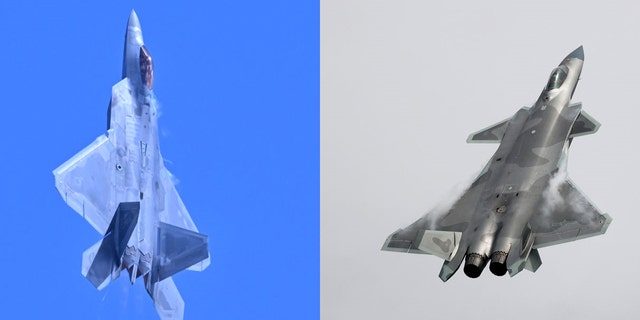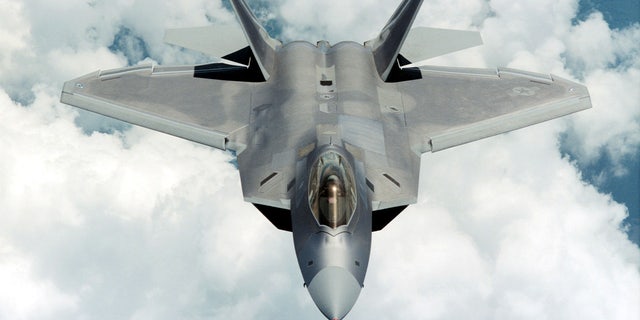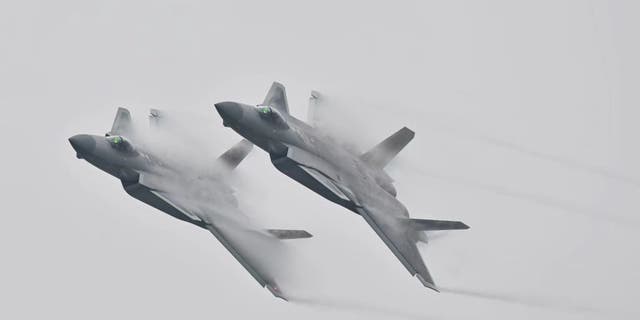close 
F-22 fighter jet, heat-seeking missile used to shoot down Chinese spy balloon
Fox News correspondent Lucas Tomlinson joins "Fox News Live" with the latest on a Chinese spy balloon being shot down by the U.S. military while hovering off the South Carolina coast.
China achieved its fifth-generation fighter jet by copying U.S. military tech, and it could maintain its pacing challenge for the American military if more isn’t done to safeguard sensitive weapons information, experts tell Fox News Digital.
“What we know is that because of the espionage efforts, [China’s] J-20 is more advanced than it otherwise would be, and that’s the important point here,” former Acting Under Secretary of Defense for Policy James Anderson said in an interview.
“They have profited greatly from their thievery over the years,” he said. “They’ve put it to good use, and they’ve come up with an advanced fifth-generation fighter,” noting that it’s “hard to say short of actual combat” how the J-20 matches up against the U.S. F-22 Raptor fighter.
China began developing its J-20 in 2008 as part of a plan to design a new fighter that could compete with those in America. The plane first took flight in 2011, with its introduction to service in 2017.
CHINA, RUSSIA CAN’T TOP OUR FABULOUS F-22 FIGHTERS
In 2015, reports on the plane’s technology and capabilities started to notice similarities between it and U.S. fighter jets, with an Associated Press report stating that “some of its technology, it turns out, may well have come from the U.S. itself.”
Now China has a fifth-generation stealth fighter, similar to the U.S. F-22, which has further closed what was once a virtually insurmountable gap between the two militaries in terms of technological capabilities – all thanks to continued intellectual property theft. The gap between U.S. and Chinese military technology has received renewed focus as tensions between the two nations continue to increase and officials continue to discuss a possible invasion of Taiwan, which might include a U.S. military response.

The F-22 Raptor, left, and the Chinese J-20 are fifth-generation fighter planes. (Paul Crock / AFP via Getty Images / File | Fu Tian / China News Service via Getty Images / File)
James Hess, professor at the School of Security and Global Studies at American Public University System (APUS), said that ultimately the U.S. has to contend with China’s “philosophical difference” and willingness to do what is “best for China.”
“You can even look in the history of China with an overall culture of things that have provided a betterment for society versus a worry about it,” Hess said. “That lack of enforcement is probably more reflective of a culture … there’s certainly a cultural aspect to this.”
US MILITARY JET FLOWN BY AI FOR 17 HOURS: SHOULD YOU BE WORRIED?
“There’s an author who said, ‘To steal a book is an elegant offense,” so you have that kind of mentality, that knowledge is not necessarily looked at as theft of knowledge … is not looked at as a capital offense by any means,” he continued. “It’s looked at as kind of good thing, that this is a positive thing you’re doing.”
Anderson explained that China uses a range of espionage techniques from the “old-fashioned” and “low-tech” use of spies and honey traps and bribery to recruit U.S. contractors, university academics and government personnel, in addition to more advanced methods such as cyberactivity to obtain key data on military systems.

A F-22 Raptor flies in this undated image provided by Lockheed Martin. (Lockheed Martin via Getty Images)
“Unfortunately, they’ve had some success there,” Anderson said, adding that they spent “well over a decade” repeatedly going after the Joint Strike Fighter, which they’ve exploited in the design and construction of the J-20.
“It saves the Chinese time and money. In effect, we end up subsidizing a portion of their research and development budget because they are successfully stealing some of our secrets,” Anderson said. “Ultimately, this puts our men and women at greater risk on the battlefield.”
BIDEN’S ‘POLITICAL’ AFGHANISTAN STRATEGY GUTTED US CREDIBILITY, ARMY VET CONGRESSMAN SAYS AS HEARINGS BEGIN
Matt McInnis, senior fellow for the Institute for the Study of War’s China program, highlighted China’s “focus … almost more than anything else” on obtaining jet engine technology after “struggling for decades” to keep up with the U.S. and Western weapons.
“As someone who’s watched China for a long time, that’s always the joke … will the Chinese ever be able to produce their own jet engine?” McInnis said. “So, they’ve slowly been able to become more independent in creating jet engines for their more advanced aircraft.”

J-20 fighter jets (VCG/VCG via Getty Images)
The drive to “understand more sophisticated jet engines” in the West has remained a significant driving force for Chinese espionage, according to McInnis.
He pointed to the 2022 case of Yanjun Xu, a Chinese spy who was convicted of trying to steal trade secrets from multiple U.S. aviation and aerospace companies, including theft of proprietary airplane engine fan technology.
AIR FORCE SIGNS $65M DEAL WITH STARTUP TO TEST ‘SUSTAINABLE’ FUEL PRODUCTION
U.S. prosecutors said Xu began recruiting experts from companies such as GE Aviation in Cincinnati as far back as 2013, but lawyers maintain he was not a spy and never asked for trade secrets.
“It really was a huge win for the United States to be able to crack this particular case, but at the same time, we still look at what China is trying to do with technology, espionage,” McInnis said, adding that China is “still probably the greatest threat to U.S. national security.”
McInnis also referred to recent efforts that included recruiting former British pilots to advise and train the People’s Liberation Army’s air force pilots, which has provided “another way they have attempted to acquire Western technical knowledge.”
CLICK HERE TO GET THE FOX NEWS APP
“The Chinese baseline of what the Russians have given them and what they were able to steal from us and from European manufacturers has brought them up to maybe only a 10- or 15-year gap between us and Chinese jet engine technology, whereas before they were much more like 20 to 30 years behind us.”
Peter Aitken is a Fox News Digital reporter with a focus on national and global news.
